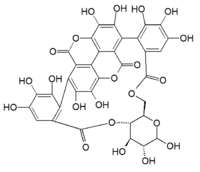Punicalin facts for kids
Quick facts for kids Punicalin |
|
|---|---|
 |
|
| Other names | 4,6-(S,S)-Gallagyl-D-glucose |
| Identifiers | |
| CAS number | |
| PubChem | |
| SMILES | c1c2c(c(c(c1O)O)O)-c3c4c5c6c(c(c(c(c6oc4=O)O)O)-c7c(cc(c(c7O)O)O)C(=O)O[C@@H]8[C@@H](COC2=O)OC([C@@H]([C@H]8O)O)O)c(=O)oc5c(c3O)O |
|
InChI
InChI=1/C34H22O22/c35-6-1-4-9(19(39)17(6)37)11-15-13-14-16(33(50)56-28(13)23(43)21(11)41)12(22(42)24(44)29(14)55-32(15)49)10-5(2-7(36)18(38)20(10)40)31(48)54-27-8(3-52-30(4)47)53-34(51)26(46)25(27)45/h1-2,8,25-27,34-46,51H,3H2/t8-,25-,26-,27-,34?/m1/s1
|
|
| Properties | |
| Molecular formula | |
| Molar mass | 0 g mol-1 |
| Except where noted otherwise, data are given for materials in their standard state (at 25 °C, 100 kPa) | |
Punicalin is a special natural chemical found in some plants. It's a type of compound called an ellagitannin. You can find Punicalin in delicious fruits like the pomegranate (its scientific name is Punica granatum). It's also present in the leaves of the Terminalia catappa tree, which is sometimes called the Indian almond tree. People have used Terminalia catappa in traditional medicine to help with skin problems like dermatitis and liver issues like hepatitis.
Punicalin is also found in Combretum glutinosum, a plant from Africa. All three of these plants (pomegranate, Terminalia catappa, and Combretum glutinosum) belong to a large group of plants called Myrtales. The last two plants are part of a family within that group called Combretaceae.
This chemical is known to be a very active carbonic anhydrase inhibitor. This means it can slow down or stop the work of certain enzymes in the body called carbonic anhydrases. These enzymes are important for many body functions.
Chemical Structure of Punicalin
Punicalin is made up of smaller chemical parts. The molecule contains a gallagic acid component. This part is connected to a sugar molecule called glucose.
See also
 In Spanish: Punicalina para niños
In Spanish: Punicalina para niños

